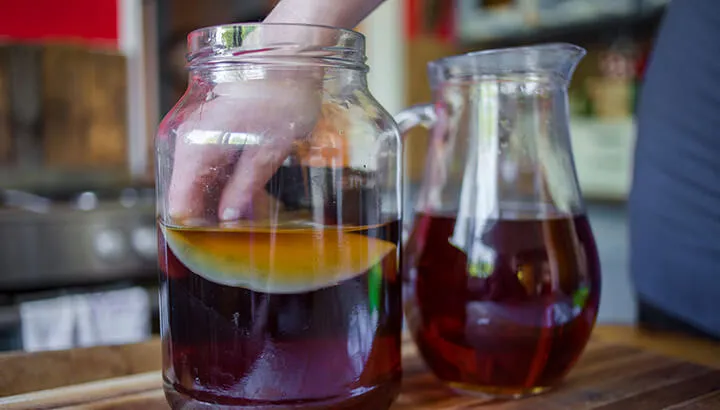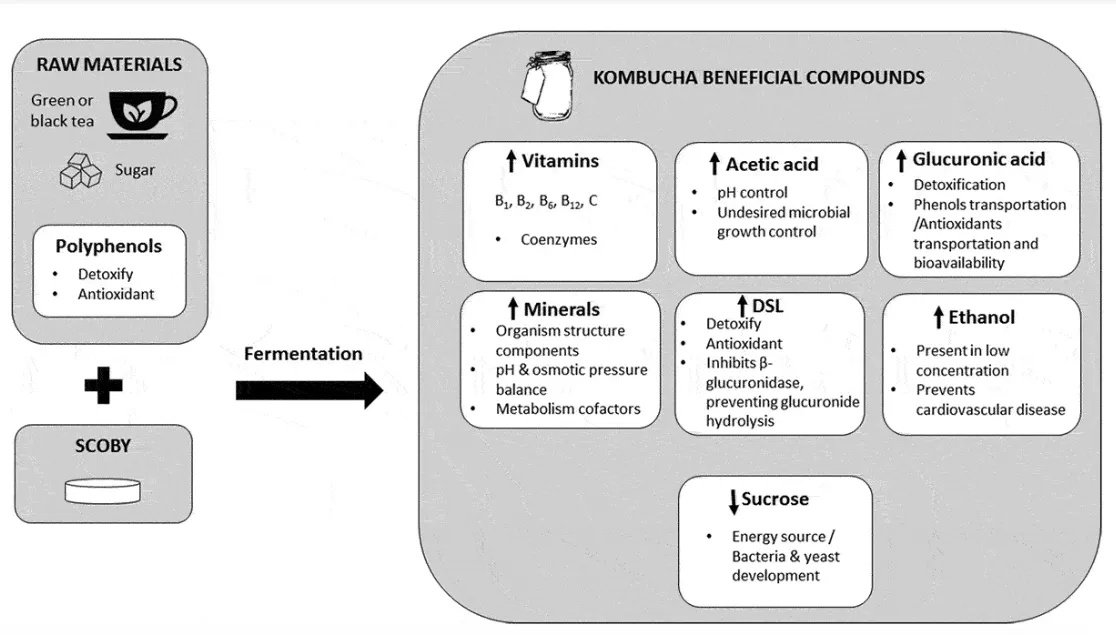Like many products before it, kombucha seemed to appear overnight. A trend had been set and the health food industry began to take notice. And like any food or beverage that hits the market, not all products are created equal — including something has healthy as kombucha.
Why consume kombucha?

Although we now have access to everything from peach to blueberry kombucha, this beverage is anything but new. In fact, the first recorded case of kombucha use was in 221 BC. Throughout China, it has long been known as “the tea of immortality,” and has since spread around the globe.
Before we jump into some of the issues surrounding modern-day, commercialized kombucha, it is important to highlight some of the key benefits.
As stated in one 2018 review, published in the Journal of Food, kombucha has been associated with health effects including improved liver function, enhanced immune function, reduced blood pressure and cholesterol levels, as well as significant gastrointestinal benefits. These effects are due to the presence and consumption of bioactive compounds.
The chemical components of kombucha and their beneficial effects are summarized in this image from Journal of Food below:

What’s the deal with store-bought kombucha?
The world of kombucha blew up in the health food industry, leading to some drastic changes. New brands started popping up one by one, and in order to remain on the shelves, they needed to taste good.
Say helllllo to commercialized, kombucha brands — a.k.a. flavored and even highly sweetened beverages that have us coming back for more. In some cases, brands even add a heavy dose of caffeine, which is alarming for parents giving their children daily doses of this “healthy” alternative.
In fact, back in 2010, there was an issue following a Whole Foods inspection. After a bottle audit by a Maine Department of Agriculture Consumer Inspector, it was found that the bottles contained alcohol levels that ranged from over 0.5 percent to 2.5 percent.
This immediately told a story: producers were not taking the necessary precautions during the second fermentation and bottling process. Since this regulation crisis, the popularity of kombucha began to steadily rise once again.
Being a microbial cocktail, without knowing what contents were used (i.e. the tea, additives and the SCOBY), as well as factors such as the incubation temperature, it can be tough to know what you’re really getting.
At over $3 a bottle, it is recommended that you brew it yourself. And if you are looking for a significant probiotic boost, you may be better off reaching for a quality kefir, as it is known to offer a significant amount of those “good bacteria” we need.
Also, don’t forget to nurture your gut flora through the regular consumption of fruits and vegetables. Meaning, kombucha is not going to completely overturn a crumbly diet all on its own. You need to maintain balance.
Should I make my own?
You may have heard some horror stories associated with homemade kombucha, as this fermented drink does pose some potential risks. After all, the fermentation process is susceptible to contamination. Since the same environment that creates harmful pathogens is required to develop friendly bacteria, it is kind of a catch-22.
And although there have been a number of serious cases associated with kombucha, the associated risk is often exaggerated. As long as you practice safe preparation methods in regards to cleanliness while avoiding carelessness, there is no reason to fear a bit of Sunday afternoon kombucha brewing.
How to make your own kombucha
For starters, you will need a healthy SCOBY (symbiotic culture of bacteria and yeast), obtained from a trusted source. To sterilize your equipment, avoid any harsh soaps or bleach, as this will harm your friendly, gut-boosting bacteria. Instead, place all of the vessels you will be using in a water bath that is over 160 degrees Fahrenheit.
- Steep your tea (black, green, jasmine, whatever you like) in hot water — I’m talking temperatures above 170 degrees Fahrenheit. Use approximately 5 grams of black or green tea leaves per liter of water.
- Next, you will need to add sugar, in the amount of approximately 50 grams per liter of water.
- Before adding your SCOBY, make sure that your beverage has dropped to around 20 degrees Fahrenheit. At each and every step, making that you are using properly sanitized utensils and vessels.
- Add your SCOBY and place a cloth over the mouth of your jar and wrap tightly. You want to keep flies away but still allow your concoction to breath.
- The first fermentation process will take a minimum of three days to a maximum of 60 days. On average, three to seven days is ideal. You will begin to notice that your kombucha is becoming fizzy.
- The second fermentation is not necessary but is ideal when you begin to experiment with new flavors. Whether you use berries or ginger juice, this period will allow all of the flavors to blend. The result is a deeper, more complex flavor.
You know what they say: practice makes perfect. Play around with various recipes and techniques. Although you can tweak your ingredients, always practice good food safety and hygiene.
So there you have it — you can now make your own kombucha to maximize its health benefits. After all, Donna Schwenk, author of Cultured Food Life said it best, “You are what your bacteria eats.”
— Krista Hillis

